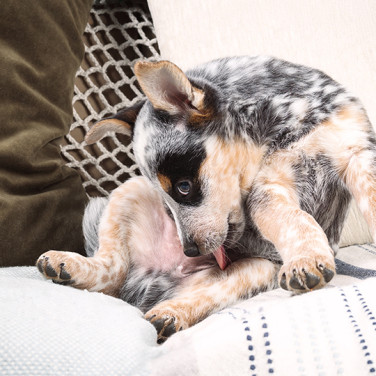DISEASES
Distichiasis in Dogs - Causes, Signs, and Treatment Options
페이지 정보
본문


What is distichiasis in dogs?
Distichiasis, also known as double-rowed eyelashes, refers to the abnormal growth of eyelashes in dogs. Typically, the eyelashes grow on the border of the eyelids, specifically from the opening of the pores in the area called the meibomian gland, which provides lubrication to the eye. Distichia disease can involve multiple eyelashes growing from different locations. It often occurs bilaterally in both eyes and can also affect the lower eyelid. Symptoms of distichiasis include pain, inflammation, frequent blinking, squinting, increased tear production, redness, and corneal ulcers. Surgical correction is recommended when clinical symptoms are present. Another similar condition to distichiasis is ectopic cilia, where eyelashes grow from the conjunctiva and directly touch the cornea instead of the eyelid border.
Causes of distichiasis in dogs
The exact cause of distichia disease, where eyelashes predominantly grow from the meibomian gland, is not yet clearly understood. However, it is known to occur congenitally in some breeds.
Symptoms of distichiasis in dogs

The clinical symptoms of distichiasis can vary depending on the number, size, and hardness of the abnormal eyelashes. In cases where the eyelashes are thin and light, clinical symptoms may not be apparent. Generally, when the eyelashes irritate the eye and cause inflammation, the following symptoms may occur:
- Frequent blinking or squinting due to pain
- Rubbing eyes frequently
- Excessive tear production
- Redness and inflammation of the eye and conjunctiva
- Corneal ulcers
Risk of distichiasis in dogs
The following breeds are known to be prone to congenital distichia disease:
Shih Tzus, Dachshunds, Golden Retrievers, Shetland Sheepdogs, Bulldogs, Boston Terriers, Pugs, Boxers, Pekingeses, Poodles, Cocker Spaniels, Welsh Springer Spaniels, Lhasa Apsos, and Chesapeake Retrievers
Untreated distichiasis can continue to cause eye irritation, pain, corneal ulcers, and secondary bacterial infections. Prolonged corneal ulcers can lead to corneal scarring and eventual blindness. It is recommended to address this problem when you notice the early clinical symptoms of distichiasis to avoid these conditions.
Home treatment of distichiasis in dogs

If the problematic eyelashes are thin and do not cause significant clinical symptoms, home management using dog-safe eye lubricant drops can be effective. However, this will be a necessary treatment method for the rest of their life if the cause is not addressed by a veterinarian.
Diagnosing distichiasis in dogs
Veterinarians can diagnose distichiasis through physical examination and ophthalmic evaluation. They can observe the abnormal eyelashes originating from the meibomian gland and assess the irritation to the cornea. Additional tests that may be conducted include:
-
Slit-lamp bio-microscope
This test gives a magnified view of the eyelid which the abnormal lashes can be examined. This test can determine the severity of distichiasis in the dog.
-
Corneal ulcer test
Fluorescein staining to evaluate corneal ulcers
-
Other eye tests
Measurement of tear production to assess corneal damage and other eye conditions
Treating distichiasis in dogs
Treatment options for distichiasis depend on the severity of symptoms. In cases where distichiasis is mild and the eyelashes are short and thin without significant symptoms, no treatment may be necessary. Ophthalmic lubricants can be used to manage symptoms and protect the cornea from mild distichiasis. However, if the eyelashes cause irritation, corneal ulcerations, or conjunctivitis, treatment is necessary. Your veterinarian or canine ophthalmologist will determine the best course of action for your dog and choose among the following treatment options.
-
Plucking
If only a few long hairs need to be removed, they can be plucked. However, the hairs will regrow, so regular plucking is required throughout your dog's life.
-
Electrolysis
Under general anesthesia, a fine electrode is inserted into the hair follicle, and an electrical current permanently removes the hair. However, this method can only remove currently visible hairs, and new ones may still grow. There may be discoloration or scarring of the eyelids.
-
Cryosurgery
This procedure is performed under general anesthesia when multiple hairs are causing problems. A probe freezes the inner surface of the eyelid to remove the hair. Discoloration or scarring of the eyelid may occur, and repeat treatments may be necessary.
-
Hotz-Celsus
This procedure involves rolling the eyelid outward and tacking it. By doing so, the contact between the troublesome hairs and the cornea is eliminated, relieving irritation.
Surgical removal of the eyelashes is generally not recommended as it can result in thicker regrowth. However, surgery may be the preferred option when distichiasis causes pain, excessive eye rubbing, or corneal ulcers. The goal of surgery is to remove the problematic eyelashes and their follicles to prevent regrowth. Surgical procedures may involve removing the affected eyelid or using methods like electrolysis, cryotherapy, or laser techniques to destroy the follicles. Scarring on the eyelids may occur after surgery, and regrowth of the eyelashes typically takes 4 to 6 weeks.
Preventing distichiasis in dogs
There are currently no known preventive measures for distichiasis in dogs. However, due to the genetic factor in its presence in certain breeds veterinarians highly suggest against breeding two affected dogs to prevent the spreading of the hereditary nature of this condition.
Find out more about your dog’s symptoms and diseases on the Buddydoc app!

The Buddydoc library is filled with everything you’d want to know about each symptom and disease your pet may experience. If you would like to find out more about the causes, signs, treatments, preventions, and more for your dog’s disease. Try out the Buddydoc app and search for your pet’s symptoms or diseases in the Buddydoc library.













